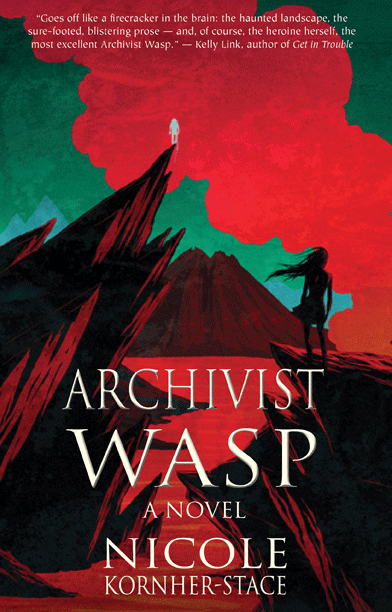
Archivist Wasp
by Nicole Kornher-Stace
Big Mouth House/Small Beer Press, 256 p.
At some point, I’m going to be able to think of an easy way to describe Nicole Kornher-Stace’s Archivist Wasp. Maybe I am, anyway. On the one hand, it’s a deeply primal story: a hero following the lead of a more ambiguous figure, journeying on a quest into the underworld, and facing demons personal and literal along the way. It’s classified as YA–at least, that’s one of the genres listed on the back–and while it hits a couple of familiar buttons (a post-cataclysm society, a young protagonist learning uncomfortable truths about that society), there’s a fundamental weirdness about this book that’s hard to shake.
I should probably be clear: that’s a really good thing, as far as I’m concerned.
Last week, I went to a reading and discussion featuring Camille DeAngelis, Maria Dahvana Headley, and Nova Ren Suma. DeAngelis wore a button reading “Keep YA Weird.” The three books being read from all focused on different ways of expressing that principle, from tales of cannibals in love to mysteriously intertwining narratives. Kornher-Stace’s book is working in a deeply primal territory, but it’s also a word in which the fundamental rules are unfamiliar. In some ways, it’s science fiction: it’s set at some unspecified point in the future, and there are occasional encounters with relics of futuristic technology. On the other hand, ghosts play a huge part in the book: Wasp, the protagonist, is tasked with researching and sometimes dispersing the ghosts that can be found around her community. But one particular ghost seems more substantial than the rest; more haunted–pardon the pun–by his own past actions.
The feeling of reading this novel was, at times, akin to reading some of Kelly Link’s short stories. The sense is strong that there is an underlying logic to all of this, that the far-future setting and the more mythologically-resonant aspects are connected in some primal way. At the same time, Kornher-Stace is working in a very different vein than Link, though they share a similar anything-goes approach and a deeply-rooted talent for upping the dread quotient considerably.
There were also moments in this that reminded me of Wim Wenders’s Wings of Desire–which, come to think of it, has probably gotten pretty deeply rooted into my head at this point. That film, too, works under some strange metaphysical logic that’s never really spelled out: why do its angels awaken in a suit of armor if they choose to become mortal? Why do angels have the ability to duplicate human objects by touching them? There is no expository dialogue given, and it makes the film much stronger. That’s also the case here: Wasp is used the properties of her world that might be strange to the reader. And while one character offers a perspective on a more familiar world, that’s also not one with which we’re familiar. It can be dizzying, but in the way that works that reconfigure expectations often are. Call this novel YA, call it science fiction or science fantasy, call it a new mythology. But by all means, call it compelling.
Follow Vol. 1 Brooklyn on Twitter, Facebook, Google +, our Tumblr, and sign up for our mailing list.
